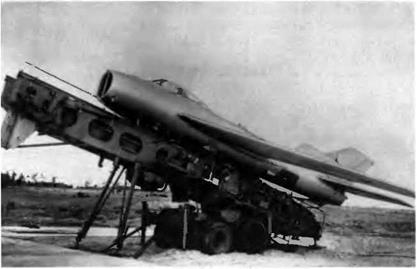MiG 19S / SM 30
In the mid-1950s the OKB masterminds had a bright idea: create a mobile launching ramp to enable a fighter to take off without an airfield. The council of ministers and the ministry of aircraft production signed two decrees in April 1955 approving the development of a powerful rocket booster tied to “a takeoff system with no takeoff roll" for the MiG-19S (a system referred to in the West as ZELL, for zero-length launch). The system was composed of a specially modified MiG-19S called the SM-30, a PU-30 launching ramp mounted on the chassis of a YaAZ-210 self-propelled vehicle, and a PRD-22 solid-propellant rocket booster. The management of the project was entrusted to M. 1. Guryevich, with A. G. Agronik responsible for the test phase.
The big girder that carried the aircraft was also the launching ramp. This PU-30 ramp-trailer had a rotating lifting device to position the aircraft. The PRD-22 booster, whose impulsion reached 39,200 daN/sec (40,000 kg st/sec), was developed by an OKB team under the command of I. I. Kartukov. Its total operating time was limited to 2.5 seconds.
Once the ramp was positioned, the aircraft—with wheels up—was placed on special brackets and attached to its rocket booster and to the guide rails with shear bolts. The ramp was set at a 15-degree angle. The pistol was at the ready. The pilot climbed the cockpit access ladder, started the two RD-9B turbojets, went to full throttle, fired up the after-

|
|
The SM-30 on its launch ramp. In early launches the aircraft’s elevators and rudder were locked for the first three seconds. |
burners, and depressed a knob to light up the booster rockets. The booster thrust added to the turbojet reheated thrust sheared the attachment bolts and imparted instantly to the aircraft a 4.5-g force. Locked at the start, the rudder and elevator were unlocked three seconds later as the aircraft left the guide rails.
Compared with the standard production aircraft, the SM-30 contained a number of modifications made necessary by the launch
process:
—the air intake duct’s upper skin panel was stiffened, as was the no. 15 frame, the lower hatches, the no. 2 fuel tank walls, and fuselage frame nos. 22, 24, 25, 26, and 30; two symmetric keels were placed under the rear fuselage to transmit the booster thrust to the aircraft —the wing root attachment was reinforced by redesigning the mounting bolts
—the attachment fittings on fuel tank nos. 2 and 3 were strengthened —a lock for the flying controls was fitted to the tail unit, as well as a pilot-operated emergency override device —the ejection seat was equipped with a special helmet meant to immobilize the pilot’s head
The first launch was made with an unmanned machine since the operation of the aircraft and all the systems had to be checked first without endangering anybody’s life. The first launch confirmed the accuracy of the design data. Two highly experienced LII pilots, G. Shiyanov and S. Anokhin, were chosen for the manned tests, which were first conducted on a runway to make sure that the pilots could handle the very high g-loads to which they would be subjected on the PU-30 ramp. Other unmanned ramp launches served to measure those g-loads more precisely. At no time did they exceed 5 g. The first manned ramp launch took place on 13 April 1957 with Shiyanov at the controls. Before the rocket booster burned out, the aircraft had already exceeded the design safety speed that kept increasing. A slight bank attitude was easily countered by the pilot, who then flew the aircraft as usual and landed back at his base.
Shiyanov was launched five times. Anokhin took to the cockpit for the sixth manned attempt as well as the seventh, on 30 June 1957, in which the aircraft carried its full payload—two rocket pods and two 760-1 (201-US gallon) drop tanks. After the eighth launch (made by Shiyanov) the ramp and the SM-30 were moved to the GK Nil VVS test center, where V. G. Ivanov, a military test pilot, was launched six times. Five other military pilots, L. M. Kuvshinov, V. S. Kotlov, M. S. Tvelenyev, A. S. Blagoveshchenskiy, and G. T. Beregovoy (a future spaceman) made one launch each.
This extract from the final test report is especially noteworthy:
1. The launching phase does not present any particular difficulty and can be managed by any MiG-19 pilot
2. When launched with unlocked flying controls, the pilot feels much more secure because he can intervene at any time; besides, the locking system proved to be useless
3. To weigh the tactical pros and cons of such a system, it would be advisable to build a small batch of units (ramp + aircraft)
4. It is essential to develop a reliable landing system that does not require a runway
Expressed that way, the last point called on engineers to attempt the impossible. Nevertheless, they endeavored to reduce landing roll in two ways. The first involved the deployment of large drag chutes before touchdown, while the second entailed the use of arresting gear like that on aircraft carriers. Steel wires linked to hydraulic brakes by pulley blocks were set across the runway, and a MiG-19SV was equipped with an arrester hook whose control and position indicators were located in the cockpit. With this device the MiG-19 could be brought to a stop in 120 m (394 feet) after hooking the wires, with deceleration forces reaching -2 g. Once the tests were completed, a demonstration was given to Marshal G. K. Zhukov, minister of defense, who also endorsed the concept of landing without runways. The ramp
|
|
Because of its compound power plant, the MiG-19SU or SM-50 offered exceptional performance.
launching system was subsequently abandoned, but the idea of rocket – assisted takeoff (RATO) from runways continued to be explored.












